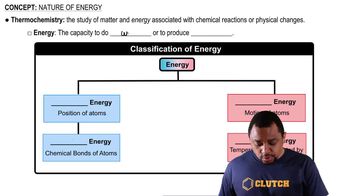An element has two naturally occurring isotopes. Isotope 1 has a mass of 120.9038 amu and a relative abundance of 57.4%, and isotope 2 has a mass of 122.9042 amu. Find the atomic mass of this element and identify it.
Ch.2 - Atoms & Elements
Chapter 2, Problem 86
Silicon has three naturally occurring isotopes (Si-28, Si-29, and Si-30). The mass and natural abundance of Si-28 are 27.9769 amu and 92.2%, respectively. The mass and natural abundance of Si-29 are 28.9765 amu and 4.67%, respectively. Find the mass and natural abundance of Si-30.

Verified Solution
Video duration:
7mWas this helpful?
Key Concepts
Here are the essential concepts you must grasp in order to answer the question correctly.
Isotopes
Isotopes are variants of a chemical element that have the same number of protons but different numbers of neutrons, resulting in different atomic masses. For example, silicon has three isotopes: Si-28, Si-29, and Si-30, each with distinct masses and natural abundances. Understanding isotopes is crucial for calculating average atomic mass and interpreting elemental properties.
Recommended video:
Guided course

Isotopes
Natural Abundance
Natural abundance refers to the relative proportion of each isotope of an element found in nature, usually expressed as a percentage. In the case of silicon, the natural abundances of Si-28 and Si-29 are given, and the abundance of Si-30 can be determined by subtracting the known abundances from 100%. This concept is essential for calculating the weighted average mass of an element.
Recommended video:
Guided course

Nature of Energy
Average Atomic Mass
The average atomic mass of an element is calculated by taking the weighted average of the masses of its isotopes, based on their natural abundances. This value reflects the mass of a typical atom of the element as it occurs in nature. To find the average atomic mass of silicon, one must consider the contributions of each isotope's mass multiplied by its natural abundance.
Recommended video:
Guided course

Atomic Mass
Related Practice
Textbook Question
10291
views
1
comments
Textbook Question
An element has four naturally occurring isotopes with the masses and natural abundances given here. Find the atomic mass of the element and identify it.
Isotope Mass (amu) Abundance (%)
1 135.90714 0.19
2 137.90599 0.25
3 139.90543 88.43
4 141.90924 11.13
2062
views
Textbook Question
Bromine has two naturally occurring isotopes (Br-79 and Br-81) and has an atomic mass of 79.904 amu. The mass of Br-81 is 80.9163 amu, and its natural abundance is 49.31%. Calculate the mass and natural abundance of Br-79.
8886
views
3
rank
1
comments
Textbook Question
Use the mass spectrum of europium to determine the atomic mass of europium.
686
views
Textbook Question
Use the mass spectrum of rubidium to determine the atomic mass of rubidium.
857
views
Textbook Question
How many sulfur atoms are there in 5.52 mol of sulfur?
1811
views
1
rank
